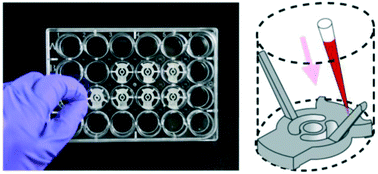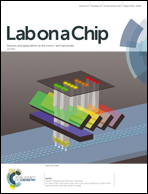Upgrading well plates using open microfluidic patterning†
Abstract
Cellular communication between multiple cell types is a ubiquitous process that is responsible for vital physiological responses observed in vivo (e.g., immune response, organ function). Many in vitro coculture strategies have been developed, both in traditional culture and microscale systems, and have shown the potential to recreate some of the physiological behaviors of organs or groups of cells. A fundamental limitation of current systems is the difficulty of reconciling the additional engineering requirements for creating soluble factor signaling systems (e.g., segregated cell culture) with the use of well-characterized materials and platforms that have demonstrated successful results and biocompatibility in assays. We present a new open-microfluidic platform, the Monorail Device, that is placed in any existing well plate or Petri dish and enables patterning of segregated coculture regions, thereby allowing the direct upgrade of monoculture experiments into multiculture assays. Our platform patterns biocompatible hydrogel walls via microfluidic spontaneous capillary flow (SCF) along a rail insert set inside commercially available cultureware, creating customized pipette-accessible cell culture chambers that require fewer cells than standard macroscale culture. Importantly, the device allows the use of native surfaces without additional modification or treatments, while creating permeable dividers for the diffusion of soluble factors. Additionally, the ease of patterning afforded by our platform makes reconfiguration of the culture region as simple as changing the rail insert. We demonstrate the ability of the device to pattern flows on a variety of cell culture surfaces and create hydrogel walls in complex and precise shapes. We characterize the physical parameters that enable a reproducible SCF-driven flow and highlight specialized design features that increase the ease of use of the device and control of the open microfluidic flow. Further, we present the performance of our platform according to useful coculture criteria, including permeability and integrity of our hydrogel walls and surface-sensitive cell culture. Lastly, we show the potential of this type of platform to create modular multikingdom culture systems that can be used to study soluble factor signaling between mammalian cells, bacteria, and fungi, as well as the potential for adaptation of this technology by researchers across multiple fields.

- This article is part of the themed collection: Lab on a Chip Emerging Investigators


 Please wait while we load your content...
Please wait while we load your content...